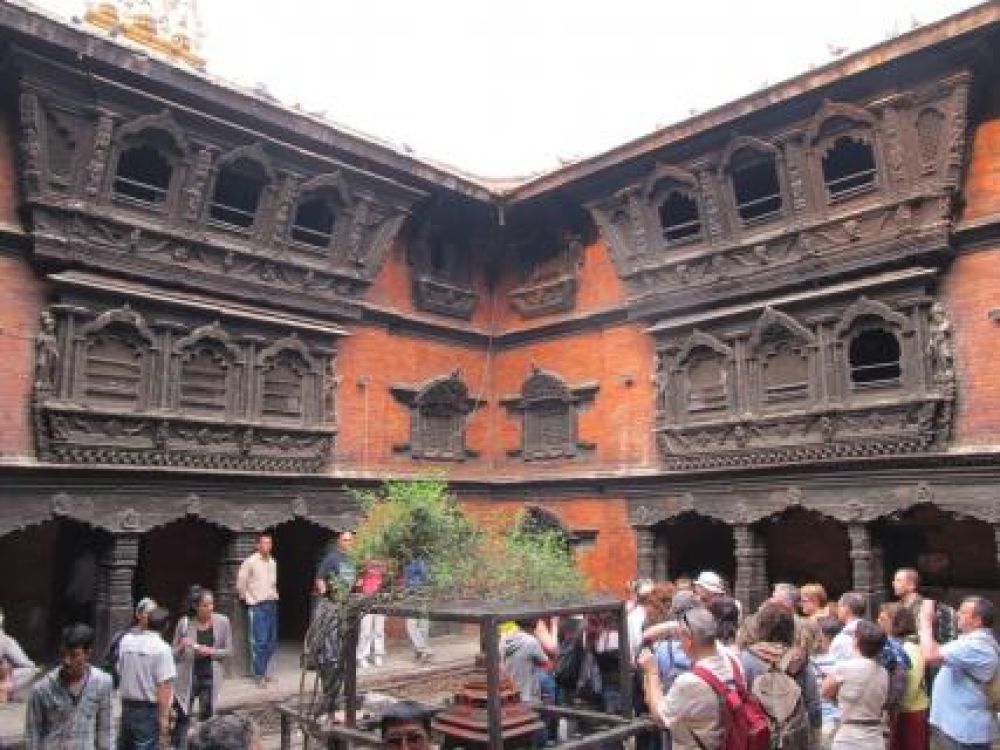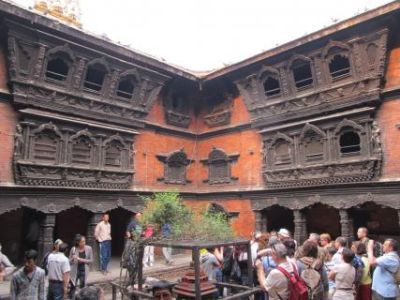

Kumari Ghar, the palace of the living goddess, is situated in the bustling area of Kumari Chowk, in Kathmandu, Nepal. This historical landmark is a significant cultural attraction where visitors can experience the rich traditions of Nepalese royalty and spiritual beliefs. As you step through the elaborately carved wooden doors, you enter a courtyard steeped in ancient practices. The living goddess, or Kumari, is a young prepubescent girl who is revered as a manifestation of divine female energy. Tourists may catch a glimpse of the Kumari as she appears briefly at her window or during various festivals. The wood-carved balconies, windows, and panels are exemplary pieces of Newari craftsmanship, revealing stories of gods and goddesses. Visitors are advised to be respectful of the customs and photographing the Kumari is generally not permitted.
The Hanuman Dhoka Palace Complex, which is in close proximity to Kumari Chowk, is a historical seat of royalty. The palace is a sprawling museum that showcases artifacts, statues, and thrones from Nepal's royal history, offering a deep insight into the country's regal past. The museum is named after a statue of Hanuman, the monkey god, placed at the entrance of the palace. Visitors can explore the museum's multiple courtyards, beautifully adorned with intricate wood carvings and stone inscriptions. The museum offers a glimpse into the history of Kings of Nepal, with rare exhibits, paintings, and murals. Exploring this museum is a time-traveling experience through the heart of Nepalese culture and history, a definite must-do for history buffs and cultural enthusiasts alike.
Kathmandu is a treasure trove of traditional Newari cuisine, which is an integral part of the cultural heritage of the Newar community of Nepal. In a cozy restaurant or a local eatery around Kumari Chowk, guests can savor authentic Newari dishes such as momo (dumplings), yomari (rice flour dumplings filled with sweet fillings), chatamari (rice crepe), and bara (lentil patties). Many of these eateries offer a rustic ambiance reflective of Newari culture, where patrons can enjoy not just the food but also the traditional setting. Such culinary experiences also often entail sampling local beverages like Ayla (a potent Newari liquor) and Thwon (fermented rice beer). A visit to one of these eateries isn't just a meal; it's a dive into the history and culture of Kathmandu's indigenous people.
Venturing out on foot around Kumari Chowk leads to the heart of Old Kathmandu, where culture, history, and architecture converge. This walking tour can take you through the narrow alleys lined with centuries-old buildings, small traditional shops, and local markets selling everything from spices to handicrafts. You'll witness the daily life of the locals, the rituals being performed in various small temples, and might even encounter ceremonial processions. Key attractions include Indra Chowk's vibrant marketplaces and the iconic Ason Bazaar. The walk is not just a physical journey but an exploration of the living history and traditions that still thrive in modern Kathmandu. Visitors are recommended to hire a local guide who can provide in-depth knowledge about the history and legends of the area.
Just a short distance from Kumari Chowk lies the enchanting Garden of Dreams, a neoclassical historical garden created in the early 20th century. This oasis of greenery provides a tranquil escape from the bustling city with its well-kept lawns, pavilions, and fountains. Visitors can stroll through the serene pathways, read a book on one of the many benches, or simply relax and absorb the peaceful atmosphere. The garden is also home to a variety of flora, and its pavilions are excellent examples of European architectural style. An ideal place for both relaxation and photography, the Garden of Dreams is a testament to Kathmandu's potential for combining heritage with tranquility.
Thamel, a bustling tourist hotspot near Kumari Chowk, is a paradise for shoppers seeking to purchase souvenirs and experience the local market vibe. With its maze of narrow streets lined with an array of shops and stalls, visitors can buy a wide variety of items such as handmade Tibetan carpets, traditional Nepali handicrafts, Pashmina shawls, prayer wheels, and much more. Thamel is not just about shopping; it's an experience filled with vibrant colors, tantalizing smells of street food, and the sounds of busy market life. Bargaining is expected, and a good deal is often part of the fun. Tourists can also find travel agencies, currency exchange counters, and outdoor gear stores within this lively neighborhood.
For a truly unique experience near Kumari Chowk, hop onto one of Kathmandu's traditional cycle rickshaws. These three-wheeled vehicles offer an eco-friendly way to navigate the narrow streets and experience the city's dynamic pulse from a different perspective. Rickshaw rides in Kathmandu are not only a convenient mode of transport but also sustain the livelihoods of many local rickshaw drivers. The leisurely pace allows passengers to take in the sights and sounds around them, including the old buildings, markets, and daily life of the locals. It's advisable to negotiate the fare before setting off, as prices can vary based on distance and time. Besides being practical, a rickshaw ride can be considered a supporting gesture towards the city's traditional economic practices.
Asan Tole, a few minutes away from Kumari Chowk, is one of Kathmandu's oldest and busiest markets, offering a feast for the senses. This traditional market area is always teeming with activity as local vendors sell a wide assortment of goods like fresh vegetables, spices, textiles, and religious artifacts. Visitors can immerse themselves in the daily hustle and bustle and observe the bartering process that is an inherent part of local commerce. The vivid colors, diverse array of products, and the chorus of sellers calling out to prospective customers create a vibrant atmosphere. A visit to Asan Tole is an opportunity to interact with the local community and to gain a deeper understanding of Nepal's commercial and cultural mosaic.
In the spiritual streets near Kumari Chowk, travelers can find a tranquil escape by attending a yoga and meditation session. Kathmandu, with its deep-rooted spirituality, is the perfect place to engage in these ancient practices that are known to enhance well-being. Numerous centers and retreats around the area offer classes led by experienced instructors for practitioners of all levels. Whether you choose a rooftop class with views of the cityscape or a quiet studio adorned with Buddhist and Hindu symbols, the experience transcends mere physical exercise, inviting a deeper connection with the inner self and the vibrant culture surrounding you.
A short drive from Kumari Chowk would take you to the ancient city of Bhaktapur, known for its skilled potters and artisanal pottery workshops. Participating in a pottery workshop allows visitors to learn about traditional techniques that have been passed down through generations. Under the guidance of a master potter, attendees can try their hand at the potter's wheel to shape their own creation. These workshops not only teach a new skill but also provide insight into Nepal's artistic heritage. At the end of the workshop, participants will have a handcrafted souvenir to take home, along with an enriching cultural experience.
